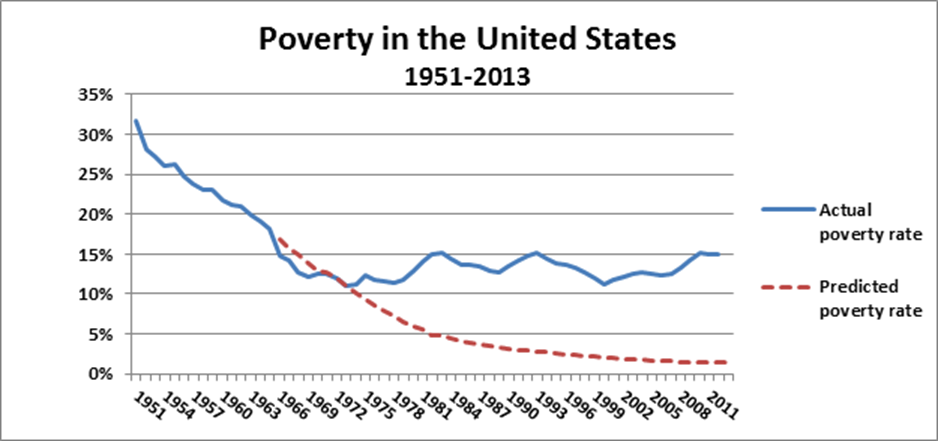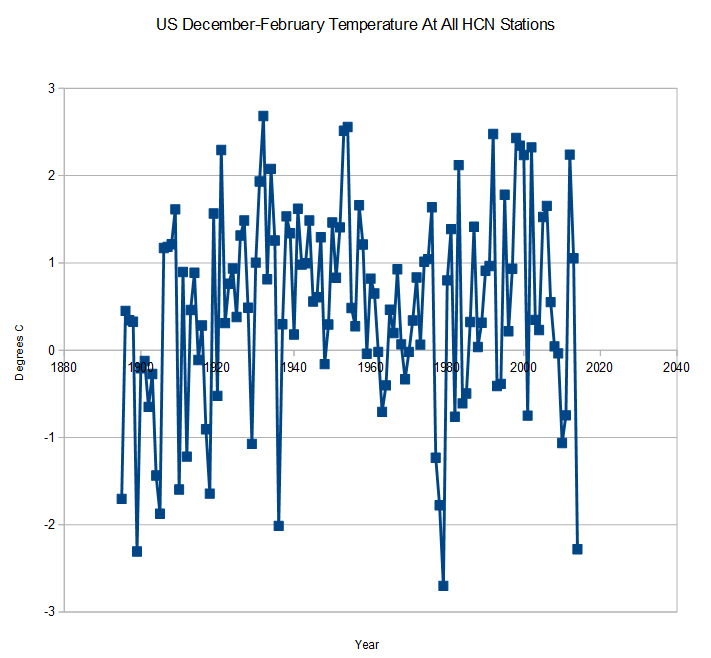http://townhall.com/columnists/johncgoodman/2014/02/08/why-we-lost-the-war-on-poverty-n1791483 ^ | February 8, 2014 | John C. Goodman
Posted on 2/8/2014 10:36:44 AM by Kaslin
Take a look at the graph below. From the end of World War II until 1964 the poverty rate in this country was cut in half. Further, 94% of the change in the poverty rate over this period can be explained by changes in per capita income alone. Economic growth is clearly the most effective antipoverty weapon ever devised by man.
The dotted line shows what would have happened had this trend continued. Economic growth would have reduced the number in poverty to a mere 1.4% of the population today ? a number so low that private charity could probably have taken care of any unmet needs.
But we didn't continue the trend. In 1965 we launched a War on Poverty. And as the graph shows, in the years that followed the portion of Americans living in poverty barely budged. In 1965, 18% of the population lived in poverty. Today we are at 15%, or 50 million Americans. That's after spending $15 trillion on antipoverty programs and continuing to spend $1 trillion a year.

Now here is something you may not know. Early on ? in the first decade of our 50-year experiment with an expanded welfare state ? carefully controlled experiments funded by the federal government established without question that welfare changes behavior. It leads to the very behavioral changes that keep people in a state of poverty and dependency. Think about that. Any serious social science debate about the effects of welfare on the behavior of the recipients was resolved four decades ago!
We now know a lot about how behavior affects poverty. In fact, if you do these four things, it's almost impossible to remain poor:
1. Finish high school,
2. Get a job,
3. Get married, and
4. Don't have children until you get married.
So how does welfare affect behavior? In the late 1960s the federal government sought to find that out in what Charles Murray calls "the most ambitious social science experiment in history."
The experiments were all conducted by social scientists who believed in the welfare state and had no doubt about its capacity to be successful. In other words, they were confident of the answers before the experiments ever began. Their goal was to prove that popular wisdom was all wrong ? that welfare would not cause people to reduce their work effort, to get married less often, divorce more quickly or engage in other dysfunctional behavior.
The experiments were all controlled. Randomly selected people were assigned to a "control group" and an "experimental group." The latter received a guaranteed income, and the program even used Milton Friedman's term for it: a negative income tax. The largest, longest and best-evaluated of these experiments was SIME/DIME (Seattle Income Maintenance Experiment/Denver Income Maintenance Experiment) in Seattle and Denver. And the results were not pretty. To the dismay of the researchers, they largely confirmed what conventional wisdom had thought all along. As I reported in "Privatizing the Welfare State":
· The number of hours worked dropped 9% for husbands and 20% for wives, relative to the control group. For young male adults it dropped 43% more.
· The length of unemployment increased 27% among husbands and 42% for wives, relative to the control group. For single female heads of households it increased 60% more.
· Divorce increased 36% more among whites and 42% more among blacks. (In a New Jersey experiment, the divorce rate was 84% higher among Hispanics.)
BTW, these results have been studied and studied over and over again and there is a large literature on them ? almost all of it written by researchers who detested the outcomes. Good summaries are provided by Charles Murray and Martin Anderson.
Both authors point out that the results are even worse than they at first appear. For one thing, the "control group" had access to conventional welfare available in the 60s and 70s. So this was by no means a pure (welfare free) control group. Also the enrollees were given different instructions about how long they could expect their guaranteed income to last. It turns out that the longer the guarantee, the worse the negative effects.
So far as I can tell there was no marriage penalty in these experiments ? certainly nothing like we have today ? and little or no penalty for earning a higher income. With the passage of time all these incentives have become increasingly more perverse. For example, over the past 50 years we have added one marriage penalty after another to welfare benefits. There is a very strong marriage penalty in ObamaCare, for example. And even Paul Krugman concedes that the marginal tax rate faced by low-income families is in excess of 80% today. (It actually goes above 100% in many cases.) And ObamaCare will make the penalty for working and earning even higher.
So here is the important public policy question: If it is well established that self-sufficiency is closely related to working and being married why are we "fighting poverty" by doing things that social scientists have known for decades lead to less work and fewer marriages?
And here is a public discourse question: why are New York Times columnists Paul Krugman and Nicholas Kristof declaring the War on Poverty a success when it is so obviously a failure? Both columnists claim that if we count goods-in-kind (Food Stamps, housing, Medicaid, etc.), the actual poverty rate would be lower by one-third. Of course, if we give people enough stuff and count it as income, we could declare victory and claim that there is no more poverty.
Dylan Matthews makes much the same point that Krugman and Kristof make. After citing a Columbia University study on the different ways of measuring poverty, he zeroes in on the key point (how much difference does government make?) and says this:
…[T]he most noticeable trend here is that the gap between before-government and after-government poverty just keeps growing. In fact, without government programs, poverty would have actually increased over the period in question. Government action is literally the only reason we have less poverty in 2012 than we did in 1967.
Reviewing some of the early literature, I find it very difficult to determine what Lyndon Johnson would have called "success" in the war on poverty. But there is no doubt in my mind what the average citizen thinks success is. The goal is to have people earning enough and saving enough to support themselves above a poverty level income without any help from government.
So by that measure, there has been no progress at all ? despite spending $1 trillion a year on the effort.

 Mathew Scott; Hair and makeup by Raina Antle
Mathew Scott; Hair and makeup by Raina Antle
 that received
that received 












